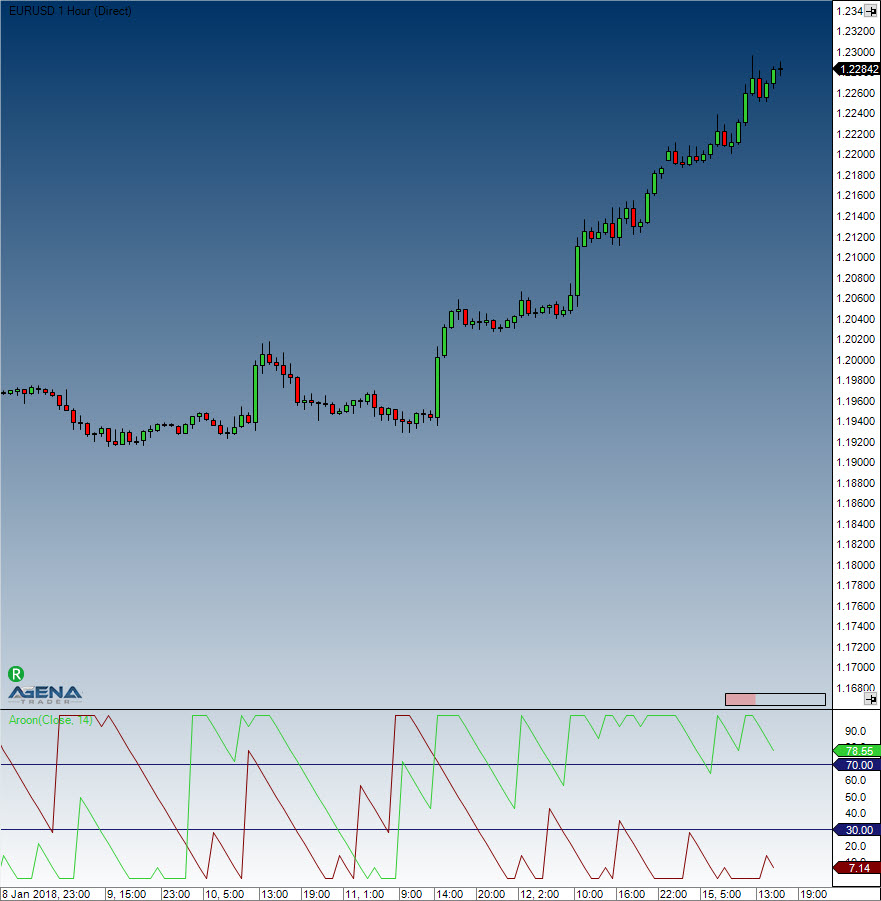Aroon
Description
Aroon, an indicator system that determines whether or not a stock is trending and how strong this trend is, was developed by Tushar Chande in 1995. Its name is derived from the Sanskrit “dawn’s early light”. Chande used this name to signify the indicators’ purpose of revealing the start of a new trend. These indicators measure the number of periods since the last time the price recorded an x-day high or low. There are two distinct indicators: the Aroon-Up and Aroon-Down, whereby a 50-day Aroon-Up measures the number of days since a 50-day high, and a 50-day Aroon-Down measures the days since a 50-day low. This makes the Aroon indicators significantly different from the usual momentum oscillators, which concentrate on price in relation to time. What makes Aroon indicators unique is that they focus on time in relation to price. Aroon indicators can be used to detect emerging trends, identify consolidations, anticipate reversals and define correction periods.
Interpretation
The Aroon indicators fluctuate above/below a centerline (50) and are bound between 0 and 100. These three levels are important for interpretation. At its most basic, the bulls have the edge when Aroon-Up is above 50 and Aroon-Down is below 50. This indicates a greater propensity for new x-day highs than lows. The converse is true for a downtrend. The bears have the edge when Aroon-Up is below 50 and Aroon-Down is above 50.
A surge to 100 indicates that a trend may be emerging. This can be confirmed with a decline in the other Aroon indicator. For example, a move to 100 in Aroon-Up combined with a decline below 30 in Aroon-Down shows upside strength. Consistently high readings mean prices are regularly hitting new highs or new lows for the specified period. Prices are moving consistently higher when Aroon-Up remains in the 70-100 range for an extended period. Conversely, consistently low readings indicate that prices are seldom hitting new highs or lows. Prices are NOT moving lower when Aroon-Down remains in the 0-30 range for an extended period. This does not mean prices are moving higher though. For that we need to check Aroon-Up.
Further information
http://stockcharts.com/school/doku.php?id=chart_school:technical_indicators:aroon
Usage
Aroon(int period)
Aroon(IDataSeries inSeries, int period)
//For the upper value
Aroon(int period).Up[int barsAgo]
Aroon(IDataSeries inSeries, int period).Up[int barsAgo]
//For the lower value
Aroon(int period).Down[int barsAgo]
Aroon(IDataSeries inSeries, int period).Down[int barsAgo]Return value
double
When using this method with an index (e.g. Aroon(20)[int barsAgo] ) the value of the indicator will be displayed for the last referenced bar.
Parameters
inSeries Input data series for the indicator
period Number of bars taken into consideration when calculating the values
Visualization

Example
Last updated